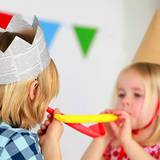Shop
01795
https://www.under5s.co.nz/shop/Hot+Topics+Articles/Toys+Books+Play/Benefits+of+play/What+is+heuristic+play.html
What's all the fuss about heuristic play?
|
Heuristic play is about playing with real-life, everyday objects and providing kids with an opportunity for open-ended discovery. When children are involved in heuristic play, they are using familiar objects in different ways. It is the process of exploring the different ways to use the objects that is important in the play.
|
You might also be interested in ...
Outdoor learning fun for under 2s
Have a go at some of these fun outdoor activities with your baby or toddler to help encourage learning through play.
Kids indoor & outdoor party games
All kids love playing party games! So here are some tips and suggestions on fun-packed indoor and outdoor games which are sure to be a big hit.
join usJoin us on social media for all our latest news. |
sign upSign up and receive our latest newsletters. |
|







Even in this age of technology there are still fun things around your house that children can use to explore and experience different textures and sounds.
What's all the fuss about heuristic play?
What is heuristic play?
When children are involved in heuristic play, they are using familiar objects in different ways. It is the process of exploring the different ways to use the objects that is important in the play.
The word ‘heuristic’ comes from the word ‘eurisko’ which means to learn, discover or reach an understanding of something.
And the phrase ‘heuristic play’ was a term coined by child psychologist Elinor Goldschmeid in the 1980’s to describe the activity of babies and children as they play with and explore the properties of objects from the real world.
For babies and toddlers, Goldschmeid’s approach to heuristic play revolves around them using their senses and exploring a treasure basket filled with real-world objects made from any material (apart from plastic) that comes from nature and around the house.
It is through handling and exploring these objects that babies and toddlers begin to make their own choices and decisions and start to gain an understanding of the world around them.
Treasure baskets
To begin you will need to put together a treasure basket.
Find a low-sided basket, box or tin and fill it with 20-30 real-life objects. Over time add and rotate items to help encourage new and different learning experiences and to keep interest high.
Examples of heuristic objects to put in your treasure basket include:
Setting up the play area
For heuristic play to be effective you need to set up a relaxed atmosphere, placing the basket in an uncluttered space with all other toys cleared away.
Ensure that the TV is off and set up the area ideally after your baby or toddler has been fed and is feeling settled.
To maintain interest, 30 minutes a day playing with the basket is usually enough. Then put the basket away so that your baby or toddler doesn’t tire of the objects.
There’s no need to get the basket out every day. A couple of times a week is enough.
Your role as an adult
An adult’s role in heuristic play is to sit back and be unobtrusive, interacting only when invited.
Children should be able to move freely and explore without any encouragement or distraction.
Your baby or toddler will have a much richer and more stimulating experience when they can explore at their own pace.
Please remember small children should not be left alone, especially when they are constantly putting the items in their mouth and are susceptible to choking.
Beyond treasure baskets
Day to day life also offers a platform for heuristic play.
Simple ideas include playing with clothes pegs in a container, playing with objects in the bath or a bowl of water or even banging saucepans with a wooden spoon to make your own musical instruments. The opportunities for discovery are endless.
Being outside provides a natural heuristic play area for babies and toddlers too. They can grasp at grass, leaves and flowers in the garden or play with sand and seaweed at the beach. There’s so much to discover!
More kids articles to enjoy:
- Outdoor learning fun for under 2's
- Toys on a budget
- Boredom busters
Image source: calachildhoodpractice